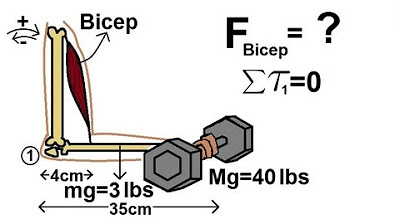What is Torque? - Fastening Theory Part 1
TLDRThe video script from Flexible Assembly's Fastening Theory educational series introduces viewers to the fundamentals of fastener strength and the role of torque in tightening. It explains that threaded fasteners, functioning like heavy springs, are crucial in clamping components together under load to prevent failure. The concept of a bolted joint, bearing surface, pre-load, and clamp load are defined, emphasizing their interdependence in maintaining structural integrity. The video presents a graph illustrating the fastener's strength in relation to stress and strain, highlighting key terms like yield strength, proof load, and ultimate tensile strength. It then breaks down the tightening process into four phases: rundown, draw-down, elastic deformation, and plastic deformation. The importance of selecting the correct fastener for a task is emphasized to avoid failure. Torque is defined as the measure of force causing rotation, with an explanation of its components, including the pivot point, force, and moment arm. The script concludes by discussing how torque is measured, its units, and the rationale behind using torque measurement as a proxy for achieving clamp force, despite the challenges posed by friction.
Takeaways
- 🔩 The primary function of a threaded fastener is to clamp multiple components together, acting as a heavy spring under load.
- 📏 Under heavy loads, fasteners can deform and change shape, so they must be strong enough to resist failure.
- 🔧 The bolted joint refers to the entire assembly of components and the fastener itself.
- 📐 The bearing surface is the part of the fastener that contacts the component it's clamping.
- 🔑 Pre-load is the initial tensile load a bolt can withstand before being pulled apart.
- 🔨 Clamp load is the compressive load that a joint can handle while being pushed together.
- 📊 Fastener strength is depicted on a graph with stress on the Y-axis and strain on the X-axis, showing how it can fracture under increasing stress and strain.
- 🔸 The yield strength is the point at which the fastener's material begins to deform permanently.
- 📈 The proof load is the fastener's usable strength, typically 85-95% of the yield strength, where it will return to its original shape after the load is removed.
- 💥 The ultimate tensile strength is the point where the fastener breaks and fails completely.
- 🔧 Tightening a fastener involves four phases: rundown, draw-down, elastic deformation with clamp load build-up, and plastic deformation.
- ⚙️ Torque is the measure of the force that causes an object to rotate around an axis, and it's crucial for achieving the desired bolt tension and clamping force.
- 📐 Torque is calculated as the cross product of the force and the perpendicular distance from the force to the axis of rotation, influenced by the length of the moment arm.
- 🔢 Measuring torque is practical for controlling the tightening process, as it can be directly measured at the fastener without needing to measure clamp force indirectly.
- 🔗 Units of torque, such as Nm or lbs. ft., represent the torque resulting from a specific force applied perpendicularly to a moment arm of a specific length.
- ⚖️ Achieving the correct torque is important as it ensures the fastener is tightened to the necessary preload, which is critical for the joint's performance and longevity.
Q & A
What is the primary function of a threaded fastener?
-The primary function of a threaded fastener is to clamp two or more components together by acting as a heavy spring between the components.
What is the term used to describe the total scope of all components being clamped together along with the fastener?
-The term used to describe this is the 'bolted joint'.
Define the term 'bearing surface' in the context of fasteners.
-The 'bearing surface' is the support surface on the fastener which mates to the part it will be clamping.
What is the difference between 'pre-load' and 'clamp load'?
-Pre-load is the state of a bolt’s tensile load, its capacity for being able to withstand being pulled apart. Clamp load is the state of a joint’s compressive load, its capacity to withstand loads while being pushed together.
What is the yield strength of a fastener?
-The yield strength of a fastener is the point of stress at which the material it is made of starts to deform permanently.
What is the proof load of a fastener and how does it relate to the yield strength?
-The proof load of a fastener is its usable strength where it will return to its original shape once the load is removed. It is typically 85-95% of the yield strength.
Define the 'ultimate tensile strength' of a fastener.
-The ultimate tensile strength is the point where the fastener is pulled to the point of breaking and fracturing, which is where the fastener will fail completely.
How does the elastic range relate to the plastic range in terms of a fastener's deformation?
-In the elastic range, a fastener can deform and safely return to its original shape once the load is removed. However, once it passes into the plastic range, it will remain permanently deformed.
What are the four phases of tightening a fastener?
-The four phases are: 1) Rundown, where there is no contact between the fastener and the components being clamped. 2) Draw-down, where the joint is seated and there is contact between all components being clamped. 3) Elastic deformation and clamp load build-up. 4) Plastic deformation, where the fastener begins to deform permanently.
Why is it important to measure torque when achieving clamp force?
-Measuring torque is important because it is easy to implement and control, and it allows for the achievement of the desired clamp force without the need to measure the force directly between mating surfaces.
What is torque and how is it measured?
-Torque is a measure of how much force acting on an object causes that object to rotate on an axis. It is measured as the cross product of the magnitude of force and the perpendicular distance from the force to the axis of rotation, commonly labeled in units like Nm (newton meters) or lbs. ft.
What is the relationship between the length of the moment arm and the resulting torque?
-The longer the moment arm, the more leverage can be used, resulting in higher torque. Conversely, a shorter moment arm with the same force applied will result in less torque.
How does friction affect the measurement of torque?
-Friction can affect the measurement of torque by altering the efficiency of the force applied. Accounting for friction is crucial to ensure accurate torque measurements, which will be discussed further in the next fastening theory video.
Outlines
🔩 Fastener Strength and Bolted Joints
This paragraph introduces the concept of fastener strength and the role of threaded fasteners in clamping components together. It explains the importance of pre-load and clamp load in maintaining the integrity of a bolted joint. The paragraph also discusses the different types of loads and how they affect the fastener's ability to resist deformation. A graph is used to illustrate fastener strength in relation to stress and strain, highlighting key terms such as yield strength, proof load, and ultimate tensile strength. The fastener's behavior in the elastic and plastic ranges is also explained. The process of tightening is broken down into four phases: rundown, draw-down, elastic deformation, and plastic deformation. The importance of selecting the correct fastener for a given job to prevent failure is emphasized.
📏 Understanding Torque and its Measurement
This paragraph delves into the definition and importance of torque in the context of fastening. It explains that torque is a measure of the force that causes an object to rotate around an axis, and it is composed of a pivot point, the applied force, and the moment arm. The concept of the moment arm and its role in generating torque through leverage is illustrated using the example of a door and its hinges. The paragraph also describes how torque is measured, including the components involved such as the axis of rotation, the applied force, and the moment arm. The relationship between force, moment arm, and the angle of application in calculating torque is detailed. It concludes with an explanation of the units used to measure torque, such as Newton meters and foot-pounds, and how different combinations of force and moment arm can achieve the same torque value. The paragraph ends by posing a question about the rationale behind measuring torque when the ultimate goal is to achieve clamp force, setting the stage for further discussion in subsequent videos.
Mindmap
Keywords
💡Fastener
💡Bolted Joint
💡Bearing Surface
💡Pre-load
💡Clamping Load
💡Fastener Strength
💡Yield Strength
💡Proof Load
💡Ultimate Tensile Strength
💡Elastic Range
💡Plastic Range
💡Torque
💡Moment Arm
💡Friction
Highlights
Exploration of the strength of a fastener and its relation to torque and tightening.
Threaded fasteners function as a heavy spring to clamp components together under heavy loads.
Bolted joint is the term for the collective components and fastener assembly.
Bearing surface is the support surface on the fastener that contacts the part being clamped.
Pre-load is the tensile load a bolt can withstand before being pulled apart.
Clamp load is the compressive load a joint can handle while being pushed together.
Both pre-load and clamp load rely on the bolt and joint structure to resist deformation.
Fastener strength is depicted on a graph with stress on the Y axis and strain on the X axis.
Yield strength is the point at which the fastener material starts to deform permanently.
Proof load is the fastener's usable strength, typically 85-95% of yield strength.
Ultimate tensile strength is the point where the fastener breaks and fails completely.
Fasteners in the elastic range can return to their original shape after load removal, unlike the plastic range.
Tightening is broken down into four phases: rundown, draw-down, elastic deformation, and plastic deformation.
Clamp-load, or preload, is the primary goal when tightening a fastener.
Torque is a measure of the force causing an object to rotate on an axis and is composed of a pivot point, force, and moment arm.
Torque is calculated as the cross product of force and the perpendicular distance from the force to the axis of rotation.
Measuring torque is practical for controlling the fastening process as it can be measured directly from the fastener.
Units of torque, such as Nm and lbs. ft., represent the torque resulting from a specific force applied perpendicularly to a moment arm.
Achieving clamp force is the goal of tightening, and measuring torque helps achieve this without needing to measure between mating surfaces.
Accounting for friction is crucial when measuring torque, which will be further explored in the next video.
Transcripts
Browse More Related Video

torque explained

Introduction to torque | Moments, torque, and angular momentum | Physics | Khan Academy

Understanding and Analysing Trusses

Physics 15 Torque Example 5 (5 of 7) The Bicep

NEVER be confused by HORSEPOWER and TORQUE again - HP and TORQUE EXPLAINED in the MOST VISUAL WAY

Torque Introduction
5.0 / 5 (0 votes)
Thanks for rating: